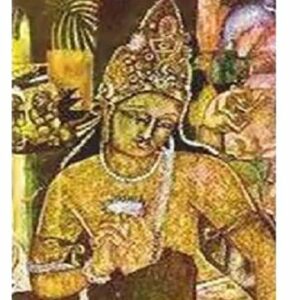Samudragupta was the second emperor of the imperial Gupta Dynasty and one of India’s greatest kings. He was a devoted fan of arts and culture, notably poetry and music, in addition to being a superb warrior, a determined conqueror, and a gracious king. He administered different policies for the northern and southern parts of India while conquering different parts of India to expand his empire – while he ruled the upper parts directly, the south, frontier states, and tribal territories were allowed autonomy and freedom, though with a definite influence on them. He is recognized as the greatest king of the Gupta Dynasty, and various western scholars have dubbed him the “Indian Napoleon” because of his numerous military conquests to expand his empire. While Ashoka promised not to fight again after the Battle of Kalinga, Samudragupta continued to conquer states and territory to construct a massive Indian military empire that would become one of the most powerful kingdoms in ancient Indian history. On gold coins and rock edicts, details of his long reign and several conquests can be uncovered.
Childhood and Adolescence
King Chandragupta I, the founder of the Gupta Dynasty, and his Licchavi princess, Kumaradevi, had a son named Samudragupta.
His father declared him the new emperor of the Gupta Dynasty a few years before his death. The decision was not accepted by the rivals for the crown, and a struggle ensued, which Samudragupta eventually won.
Reign & Accession
In 335 AD, he became the second emperor of the Gupta Dynasty and initiated an invasion of neighboring countries in order to expand his dominance and capture as much of India as possible.
To begin with, he was successful in subjugating his immediate neighbors – Achyuta Naga of Ahichchatra, Naga Sena of Padmavati, and Ganapati Naga of Mathura – establishing his dominance over the three great northern powers.
After defeating southern rulers, he reinstalled them as subordinate kings, establishing himself as a true statesman who adopted the ‘Dharma Vijaya’ strategy in contrast to the ‘Digvijaya’ prevalent in the north.
He devoted his whole focus to expanding his empire in the north once the southern kings were awarded authority and dominance over their kingdoms, and his second northern campaign started.
The war, which began with the control of the northern basin, which stretched from present-day Allahabad to the Bengali border, finished with him claiming the entire Ganges Valley, Assam, Nepal, and parts of East Bengal, Punjab, and Rajasthan.
By winning all of his campaigns, he was able to conquer a large amount of the Aryavata, which translates to “country between the Himalayas and the Vindyas, and between the western and eastern seas.”
He conquered all 18 forest countries, restoring the leaders as serfs or Puricharikas, in order to consolidate his influence over isolated forest kingdoms controlled by tribes, primarily in Central India.
The rulers of surrounding nations, particularly the Kushana kings in the Kabul valley and the Saka rulers in the far north-west, eagerly agreed to pay him taxes in person because of his superiority and terrible authority.
Samatata, Devaka, Nepal, Kartripura, Kamarupa, Malavas, Yaudheyas, Abhiras, Kakas, Arjunayanas, Sanakanikas, Prarjunas, and Madrakas were among the adjacent monarchical and republican states on the boundaries.
His rule over the Indo-Gangetic Valley was dominated by his sovereignty over most of northern India, from Punjab to Assam, with tributary power granted to frontier kingdoms and southern provinces.
Although a devout adherent of Brahmanism, he showed great regard for other religions, as evidenced by the Buddhist monarch of Ceylon, Meghavarna, granting him permission to build a Buddhist monastery at Bodh Gaya in 330 AD.
He held scholarship in high regard and hence surrounded himself with poets and scholars. He was also passionate about music and was said to be a gifted lyre or veena player.
His inscriptions on gold coins and inscriptions on rock edicts, particularly the inscription on the rock edict (Ashoka pillar) in Allahabad, authored by his court poet, Harisena, are the most important sources of information on his rule and conquests.
Samudragupta’s Major Conflicts
While on his southern campaign, he conquered 12 princes in the regions of coastal Odisha, Godavari, Ganjam, Vishakhapatnam, Nellore, Krishna, and Kancheepuram, reaching as far as Kancheepuram.
To expand the Gupta Empire, he battled and exterminated the kingdoms of nine kings: Mattila, Nagadatta, Ganapati Naga, Nandin, Rudradeva, Balavarman, Naga Sena, and Achyuta, and subjugated 12 more in Aryavata.
Samudragupta’s Achievements
The amount and variety of coins in circulation during a given reign reveal a great deal about the empire’s economic situation. The monetary system was established by Samudragupta, who introduced seven varieties of coins: the Standard Type, Archer Type, Battle Axe Type, Ashvamedha Type, Tiger Slayer Type, King and Queen Type, and Lyre Player Type.
He was successful in establishing a vast empire that stretched from the Jamuna and Chambal rivers in the west to the Brahmaputra in the east, and from the Himalayan foothills in the north to the Narmada River in the south.
He was a devout adherent of Brahmanism, but he also had great regard for other faiths. The Buddhist monarch of Ceylon, Meghavarna, granted him permission to erect a Buddhist monastery in Bodh Gaya around 330 AD.
He had a vital part in extending the Gupta Empire, often known as the Golden Age of India, by encouraging study and inventions in religious, artistic, astronomical, science, dialectic, and literary areas of Hindu civilization.
Personal History and Legacy
He had a wife named Dattadevi.
He reigned the Gupta Dynasty until his death in 380 AD when he was succeeded by his son, Chandragupta II, popularly known as Vikramaditya, who saw the Empire develop.
Estimated Net worth
Samudra Gupta has a net worth of $ USD 10 million and earns a living from NA. We don’t have enough proof on Samudra Gupta’s cars or lifestyle.


